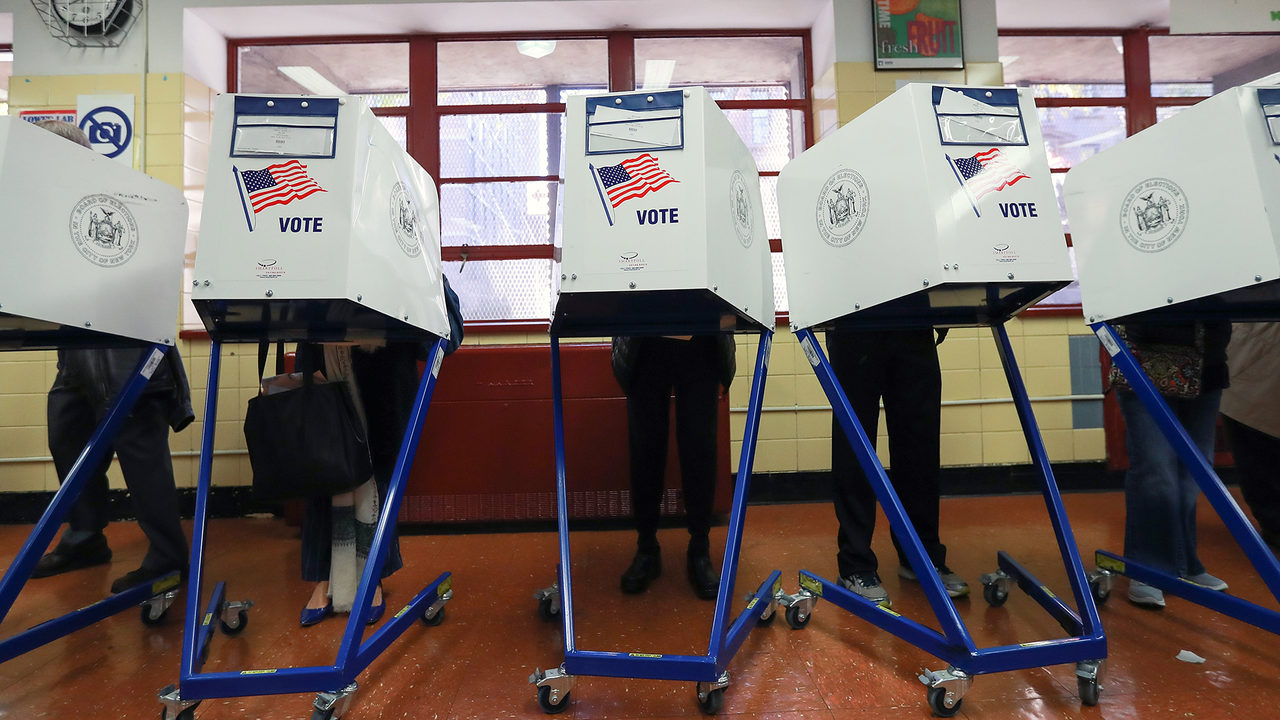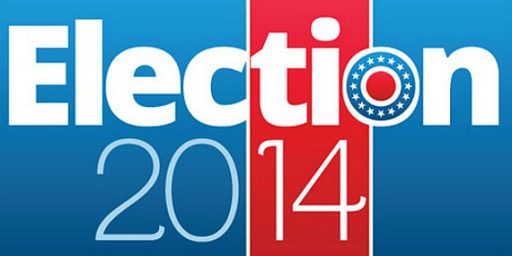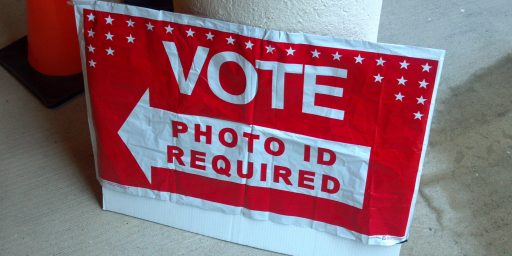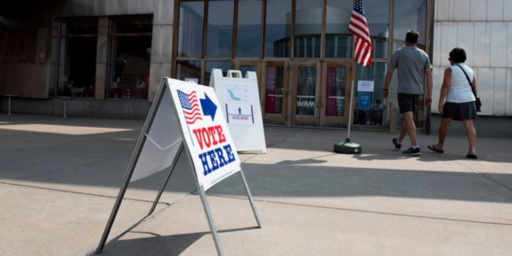Midterm Voter Turnout Was Much Higher Than Expected
Preliminary figures indicate that voter turnout in the 2018 midterms was higher than it has been for any midterm election in fifty-two years.

Voter turnout in the just-concluded midterm elections was up significantly, and we can apparently thank Donald Trump for that:
Election Day predictions of HUGE voter turnout are as old as Election Day itself.
There’s always a slew of stories, tweets and videos about really long lines at some local precinct where no one has ever seen lines like these before. And then, usually, the voter turnout nationally turns out to be nothing special or out of the ordinary: Percentages are in the high 30s or low 40s of the voting eligible population in a midterm elections year and the low 60s in a presidential year.
Except this year!
Turnout in the 2018 midterms was 49.3% of the voting eligible population, according to projections made by the United States Election Project. If it holds, that’s remarkable — and record-breaking.
In fact, according to stats maintained by Fair Vote, the 2018 turnout would be the highest midterms turnout in more than 100 years. The only close competitor was 1966, when 48.7% of the voting eligible population actually voted.
Perhaps the most amazing part of the turnout surge is where it came from as compared to 2014, when just 36.7% of the eligible population voted — a 70-year low.
What explains the difference? It’s hard not to ascribe it to Donald Trump, who wasn’t president in 2014, but is in 2018. Yes there are other contributing factors, but Trump is absolutely a turnout driver — for both parties. According to the 2018 exit poll, 67% of voters said Trump was a factor in their vote, with almost four in 10 saying they saw their vote as a way to send a message of opposition to the President.
It’s also being reported that Democrats nationwide received nearly as many votes in the 2018 midterms as Hillary Clinton and Donald Trump did individually in the 2016 Presidential election:
According to the Cook Political Report’s David Wasserman, the Dem popular vote advantage is now a full 8 points, 53.1 percent to 45.1 percent.
Indeed, Dems are getting close to 60 million votes. In 2008, John McCain got 60 million votes; Mitt Romney got 61 million in 2012; and Trump got 63 million in 2016. It’s stunning that Dems got as many House votes as the GOP presidential nominees in 2008/2012/2016
Actually, I’m not quite as surprised by these numbers as some of the national pundits are. Yes, voter turnout near 50% is extraordinary for a midterm election, but there are several factors arguably unique to 2018 that made this possible. First of all, it’s worth noting that several of the most high-profile races in the country — including the Texas Senate race between Beto O’Rourke and Ted Cruz, the Florida Governor’s race between Ron DeSantis and Andrew Gillum, and the Florida Senate race between Bill Nelson and Rick Scott — took place in some of the most heavily populated states in the country. Other heavily populated states, such as California and New York, had competitive races of their own at the statewide and Congressional level that likely helped to increase voter turnout. While we have yet to see voter turnout level at the state level, it’s likely that turnout was up significantly in these states thanks to the fact that these races were on the ballot.
All that being said, it’s hard to discount the reality that much of the turnout was motivated by the public reaction to President Trump, and that most of those people voting with Trump in mind were doing so based on disdain for the President and the desire to send a message to him and to Congressional Republicans. As has been the case since he first took office, President Trump remains one of the least popular Presidents since the end of the Second WorldWar. Given that, it isn’t surprising that large numbers of people were motivated by the desire to vote against the President and his party notwithstanding the fact that the President is not on the ballot. This became especially true once President Trump started telling his supporters that he really was on the ballot. While this was obviously meant to motivate Republicans, who remain highly supportive of the President, to get out to the polls despite the fact that the forecast looked grim, it’s just as likely that this helped Democrats who spent the better part of the year trying to make the election about the President.





When women and young people fully internalize that when they turn out they can yank government out of the hands of angry dumb elderly assholes, shit’s gonna get real different, real quick.
OT: GM got a huge tax break from the GOP in 2017. So what are they going to do? Lay off 15% of their workforce next year.
https://www.businessinsider.com/gm-to-2018-11
I had previously posted the following on a different entry, but I think it’s worth repeating here. Jonathan V. Last, a Weekly Standard editor, on Twitter made the following insight:
Panic might not be the right word, but it is telling that unlike 2006 and 2010 (the last two major flips) the party in power showed up in significant numbers for this election.
Last’s analysis built on the Cook Political Report’s Dave Wasserman:
To that point Cook’s analysis of the exit polling reveals this:
So either way, it’s clear that Trump’s core base appears to have shown up in 2018. However, given the gaps between Trump support and the failure to hold any but the strongest Trump districts, it either means that overall Republican turnout was depressed or more Democrats showed up.
Trump, despite the best efforts of the voter suppression police, managed to get a lot of people off their asses and registered. And it wasn’t new Republican voters.
As an example of one future effect of this election, I think they just moved the timeline up for when Texas turns blue.
@mattbernius:
Nate Silver made the same point about El Cheeto’s base.
In short, Trump remains very popular among Republicans, but there are fewer Republicans.
The last thing you want to lose is a fair fight. Republican turn-out was huge. They got all their troops onto the field. . . and got their asses kicked. What should really worry Trump and the Trump Party is that their best was not close to good enough, and with each orbit of the earth around the sun there are more of us and fewer of them.
Best election turnout in over 5o years and still only every other eligible voter turned out. May be a systemic problem here. In my county in Washington State, 76% in 2016 and 66% in 2018. Would be good news for Republicans as the county votes over 60% GOP except that we’re relatively rural.
I can understand low turnout. Some academic studies a few years ago found Zero correlation between what voters want and what politicians did. The only correlation was with what rich donors wanted.
Under those conditions, what’s the marginal value of voting?
This has quietly been the issue for Trump since taking office. His ceiling is capped at around 46%. His margin of error is very slim, which is why him pissing off everyone outside of his base was never smart political strategy like many pundits believed.